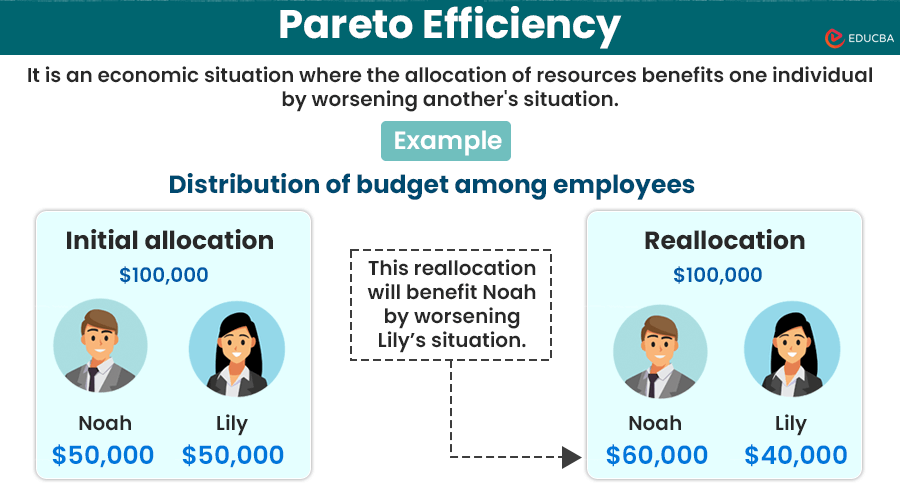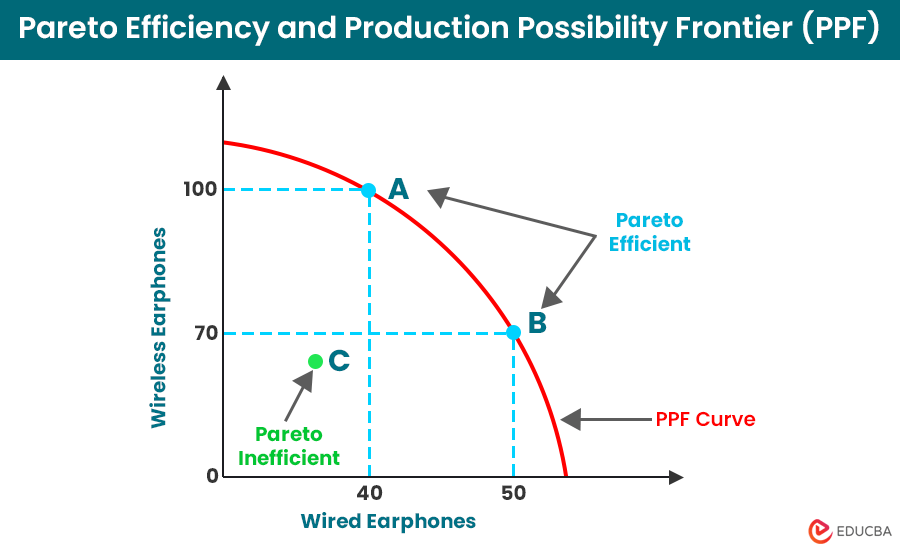
What is Pareto Efficiency?
Pareto efficiency or allocative efficiency is an economic situation in which the reallocation of resources makes the situation of one individual better by worsening the situation (causing less benefit) of another individual.
To understand this, imagine Noah and Lily , two department managers, working together on a marketing project. They have an overall budget of $100,000, which they need to split equally as $50,000 each. This means that if Lissa needs even one dollar more, she will need to take it from Nissi’s budget. Here, we can see clear Pareto efficiency, where while relocating resources, one person (Lissa) can benefit only by damaging another person’s (Nissi) situation.
Vilfredo Pareto, an Italian political scientist and economist, introduced this concept, stating that you cannot help someone without hurting someone. It is important to understand that Pareto’s efficiency occurs only when the resources are at their optimal level, which is impossible in real economic situations with regularly changing economic policies. Therefore, it is ideal as a theoretical rather than a practical concept.
Table of Content
- What is It?
- Example
- How Does It Work?
- Pareto Efficiency and PPF
- Application in Real-Life
- Limitations
Pareto Improvement
In economics, the reallocation of resources sometimes benefits one individual without harming others. This situation is the opposite of Pareto efficiency, known as Pareto improvement. Moreover, Pareto improvement can happen until a certain point, which is Pareto equilibrium, where further changes are impossible. This is where the situation becomes Pareto efficient.
Example
Let’s understand Pareto efficiency with the help of the following example.
Suppose a company has two groups: technical (Group A) and non-technical (Group B). The company wants to distribute a $10,000 bonus among employees of these two groups for their contributions.
Now, the company can use the following allocation strategies and let know why all these conditions are Pareto efficient.
| No. | Group A | Group B | Reasons |
| 1. | $10,000 | 0 | Group B will only benefit if the company takes some contribution from Group A. |
| 2. | $5,000 | $5,000 | There is equal contribution, and if the company wants to put extra money into one group, it must take it from another. |
| 3. | 0 | $10,000 | Group A will benefit if the company takes money from Group B. |
| 4. | $6,000 | $4,000 | Group A is getting more benefits by allocating less to group B. |
All the above resource distributions were Pareto efficient. However, it is important to understand that Pareto’s efficiency here does not represent equal or fair distribution. It shows that reallocating funds would not improve the overall situation without harming one group.
Pareto Efficiency and Production Possibility Frontier (PPF)
The production possibility frontier curve helps businesses utilize their available resources effectively. This curve also helps determine whether a country’s economy is at a Pareto efficient stage.
Example: Consider DFG, a company that produces wired and wireless earphones. The graph below shows the maximum quantities of earphones the company can produce with its available resources. Here, we will see how the PPF curve shows Pareto efficiency.
Graph Details:
- X-axis: Quantity of wired earphones.
- Y-axis: Quantity of wireless earphones.
Interpretations:
- Point A (40,100): The company can produce 40 wired and 100 wireless earphones with available resources.
- Point B (50, 70): The company can produce only 50 wired and 70 wireless earphones at this allocation point.
At Points A and B, the company can achieve Pareto efficiency. We can see that if the company wants to produce more wired earphones, it has to allocate more resources for that and less for producing wireless earphones. This reallocation of resources causes a shift from point A to point B on the PPF curve. Therefore, these points show Pareto’s efficiency.
Also, any points or production below these PPF curves are Pareto-inefficient, like Point C. This Pareto inefficient point signifies underutilization of resources, i.e., the company is not using its resources properly.
Application of Pareto Efficiency in Real-Life
The real-life application of Pareto efficiency is as follows.
1. Economic Policy and Resource Allocation
Pareto efficiency is useful for analyzing market equilibrium and resource allocation in economics. Policymakers must try to implement policies that allocate resources to meet various public needs and maximize the entire population’s social welfare. For example, setting optimal tax rates and allocating maximum resources to public healthcare services compared to other sectors could be Pareto efficient.
2. Environmental Protection
Governments and policymakers can use this theory for environmental management by implementing environmental regulations or sustainable programs. For instance, they can allocate a major portion of the budget to renewable energy production businesses. This allocation will benefit the environment but will not negatively impact other industries. This way, the government can maintain a Pareto improvement situation.
3. Education
A school principal or education minister can use this theory to allocate more funds to programs that will benefit students in the future. For example, they could allocate more funds to advanced technology like e-learning platforms and extracurricular activities.
4. Healthcare
In healthcare sectors, it is useful for properly allocating medical resources, such as prioritizing medical or healthcare services depending upon the severity of illness. In this way, hospitals can ensure patients get the best care.
5. Urban Development and Transportation
The development of public transportation and housing are important aspects of urban planning. Pareto efficiency can occur by allocating more resources to build new public transportation routes. This will benefit commuters by reducing travel time without adversely affecting other modes of transportation or disrupting local communities.
Limitations of Pareto Efficiency
- The concept is simple but theoretical, as it is not applicable in real-life economic situations.
- There is sometimes an unequal distribution of resources among individuals.
- The theory assumes perfect competition in Pareto situations; however, markets are never in perfect competition, leading to inefficient resource allocation.
- Applying this theory may not result in social welfare because the welfare of some people (rich) may increase while other groups of people may decrease.
Final Thoughts
Pareto efficiency is a theoretical concept with many benefits. Governments can use this theory to implement strong policies that benefit their country’s economy. However, there are also limitations, and policymakers should consider the pros and cons of this theory before implementing any economic policies.
Recommended Articles
We hope this article on ‘Pareto Efficiency’ was beneficial to you. To learn about related topics, please refer to the recommended articles below.


